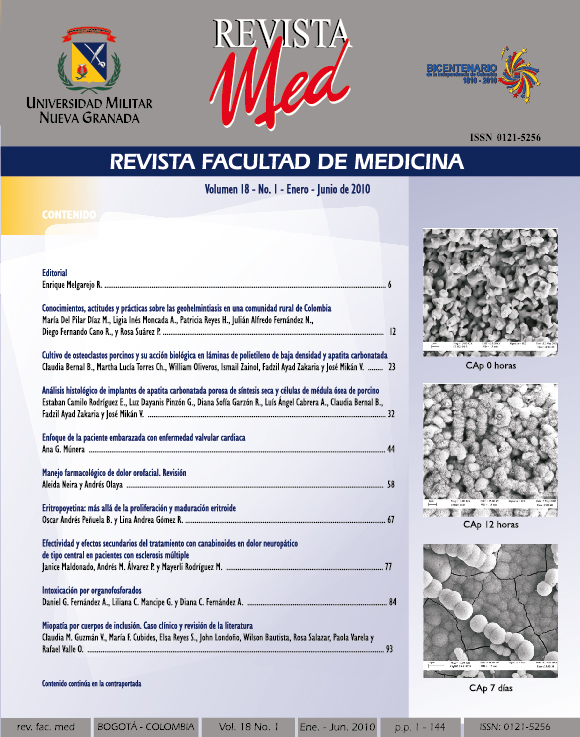Intoxicación por organofosforados
Abstract
Los compuestos organofosforados son un grupo de sustancias orgánicas derivadas de la estructura química del fósforo y tienen un gran número de aplicaciones y utilidades. Han sido utilizados como aditivos del petróleo, disolventes, en las industrias de colorantes, barnices, cuero artificial, aislantes eléctricos, impermeabilizantes, ablandadores de plásticos, fungicidas, insecticidas entre otros. Dado su amplia distribución y uso en diferentes industrias y en la agricultura, es muy frecuente que se presenten intoxicaciones accidentales por estos compuestos; además, como son sustancias que están al alcance de las personas, han sido empleadas como tóxicos en suicidios. El cuadro de intoxicación genera un síndrome clínico característico, con síntomas colinérgicos secundarios a la estimulación de los receptores de acetilcolina. El manejo médico de estos pacientes puede significar la diferencia entre la vida y la muerte, por lo que es importante que todo el personal de salud en los servicios de urgencias esté capacitado para reconocer el cuadro de intoxicación y manejarlo rápidamente en forma adecuada.
Downloads
References
Weselak M, Arbuckle T, Foster W. Pesticide Exposures andDevelopmental Outcomes: The Epidemiological Evidence.Journal of Toxicology and Environmental Healt. Part B.2007;10:41-80.
Vale J A. Toxicokinetic and Toxicodynamic Aspects of OrganophosphorousInsecticide Poisoning. Toxicology Letters.1998;102:649-52.
Eddleston M, Singh S, Bucley N. Organophosphorous Poisoning(Acute). Clinical Evidence. 2005;13:1744-55
Guidelines for Legislation on the Control of Pesticides. Foodand Agriculture Organization of the United Nations. 1989.http://www.fao.org/AG/AGP/AGPP/Pesticid.
WHO. Public Health Impact of Pesticides Used in Agriculture.Ginebra: WHO 1990. http://www.who.int/heli/risks/toxics/chemicals/en/index.html
Instituto Nacional de Salud Colombia- Subdirección deVigilancia y Control. Intoxicación Aguda por Plaguicidas.Primer Semestre de 2007. http://www.ins.gov.co/index.php?idcategoria=1470
Instituto Nacional de Salud - Subdirección de Epidemiologíay Laboratorio Nacional de Referencia- División Centrosde Control de Enfermedades. Definiciones de Caso paralos Eventos de Notificación Nacional. Sistema Nacional deVigilancia en Salud Pública SIVIGILA. http://www.ins.gov.co/?idcategoria=5579
OPS. Situación Epidemiológica de las Intoxicaciones Agudaspor Plaguicidas en el Istmo Centroamericano, 1992-2000.Boletín Epidemiológico 2002;23(3).
Reportes de vigilancia epidemiológica en Centroamérica.http://www.netsalud.sa.cr/ms/estadist/reportes/index.htm.
Lotti M. Cholinesterase Inhibition: Complexities in Interpretation.Clinical Chemistry. 1995;41:1814-8.
Eddleston M, Hillips M R. Self Poisoning with Pesticides. BritishMedical Journal. 2004;328:42-4.
Eldefrawi M E, Eldefrawi A T. Neurotransmitter Receptors asTargets of Pesticides. Journal of Environmental Science andHealth. 1983;18:65-88.
Guyton A, Hall J. Textbook of Medical Physiology, EleventhEdition 2006. 752
Dirección Seccional de Salud de Antioquia, Universidad deAntioquia. Guías de manejo de pacientes Intoxicados 2005.
Opawoye A D, Haque T. Insecticide/Organophsphorus CompoundPoisoning in Children. Annals of Saudi Medicine.1998;18:171-2.
Bleecker J D, Neucker K, Colardyn F. Intermediate Syndromein Organophosphorus Poisoning: A Prospective Study. CriticalCare Medicine. 1993;21(11):1706-1711.
Salvi R, Lara D, Ghisolfi E, Portela L, Dias R, Souza D. NeuropsychiatricEvaluation in Subjects Chronically Exponedto Organophosphate Pesticides. Toxicological Sciences.2003;72:267-271.
Weiss B, Amler S H, Amler R. Pesticides. Pediatrics.2004;113(4):1030-1036.
Worek F, Mast U, Kiderlen E, Diepold C, Eyer P. Improved Determinationof Acetylcholinesterase Activity in Human WholeBlood. Clinica Chimica Acta. 1999;288:73-90.
Reiner E, Buntic A, Trdak M, Simeon V. Effect of Temperatureon the Activity of Human Blood Cholinesterases. Archives ofToxicology. 1974;32:347-50.
Aprea C, Colosio C, Mammone T, Mimosa C, Maroni M. BiologicalMonitoring of Pesticide Exposure: A Review of AnalyticalMethods. Journal of Chromatography B. 2002;769:191-219.
Nouira, Abroug, Elatrous. Prognostic Value of SerumCholinesterase in Organophosphate Poisoning. CHEST.1994;106(6):1811-14
.23. Baer A, Kirk M, Holstege C. Organophosphates, Carbamates,Pesticides and Herbicides. In: Erickson T, Ahrens W, Ask S,Baum C, Ling L. Pediatric Toxicoloogy. Diagnosis & Managementof the Poisoned Child. 1rt. Edition. Editorial McGraw-Hill. New York; 2005: 352-356.
Maroni M. Organophosphorous Pesticides. Toxicology.2000;142:9-37.
Fillmore C, Messenger J. A Cholinesterase Testing Programfor Pesticide Applicators. Journal Occupational of Medicine.1993;35(1):61-70.
Eddleston M, Dawson A, Karalliedde L. Early Managementafter Self Poisoning with an Organophosphorous or CarbamatePesticide: A Treatment Protocol for Junior Doctors. CriticalCare. 2004;8:391-7.
American Academy of Clinical Toxicology, European Associationsof Poison Centres and Clinical Toxicologist. PositionStatement. Journal of Toxicology- Clinical Toxicology.1997;35:753-62.
Hoffman R S, Goldfrank L R. The Poisoned Patient with AlteredConsiusness. Journal of the American Medical Association.1995;274:562-69.
Bateman D N. Gastric Decontamination- A View forthe Millenium. Journal Accident and Emergency Medicine.1999;16:84-6.
Gutmann L, Besser R. Organophosphate Intoxication: Pharmacologic,Neurophysiologic, Clinical, and Therapeutic Considerations.Seminars in Neurology. 1990;10:46-51.
Sungur M, Guven M. Intensive Care Management of OrganophosphateInsecticide Poisoning. Critical Care. 2001;5;211-15.
Geller R J, Singleton K L, Tarantino M L. Nosocomial PoisoningAssociated with Emergency Department Treatment ofOrganophosphate Toxicity-Georgia 2000. Journal of Toxicology-Clinical Toxicology. 2001;39:333-36.
Heard K. Gastrointestinal Decontamination. Medical Clinics ofNorth America. 2005;89:1067-78.
Jokanovic M, Stojiljkovic M. Current Understanding of theApplication of Pyridinium Oximes as Cholinesterase Reactivatorsin Treatment of Organophosphate Poisoning. EuropeanJournal of Pharmacology. 2006;553:10-17.
Hernandez J. Intoxicación por Plaguicidas y Organofosforados.En: Guias de Práctica Clínica: Toxicología, Hospital UniversitarioSan Ignacio 2004;2:84-91.
Pope C, Karanth S, Liu J. Pharmacology and Toxicology ofCholinesterase Inhibitors: Uses and Misuses of a CommonMechanism of Action. Environmental Toxicology and Pharmacology.2005;19:433-446.
Pawar K, Bhoite R, Pillay C, Chavan S, Malshikare D, GaradS. Continuous Pralidoxime Infusion versus Repeated BolusInjection to treat Organophosphorus Pesticide Poisoning: ARandomised Controlled Trial. Lancet. 2006;368:2136-41.
Eddleston M, Mohamed F, Davies J, Eyer P, Worek F, SheriffM, Buckley N. Respiratory Failure in Acute OrganophosphorusPesticide Self-poisoning. Q J Med. 2006;99:513-522.
Roberts D, Aaron C. Management of Acute OrganophosphorusPesticide Poisoning. British Medical Journal.2007;334:629-634.
Jalali N, Pajoumand A, Abdollahi M, Shadnia Sh, PakravanN. Pesticides Poisoning: One-year Report of Loghman-Hakim Hospital Poison Center. Medical Reseacrh Program.2003;1:1-9.
Al Khod, Muscat, Oman. Potential Therapeutic Agents in theManagement of Organophosphorus Poisoning. Critical Care.2002;6(3):260-261.
Eddleston M, Darren Roberts D, Buckley N. Management ofSevere Organophosphorus Pesticide Poisoning. Critical Care.2002;6:259.
Miller M A. Organophosphorus and Carbamate Insecticides.In: Olson K. Poisson & Drug Overdose. 4th edition. McGraw-Hill. New York; 2004: 291-295.
Pajoumand A, Shadnia Sh, Rezaie A, Abdi M, Abdollahi M.Benefits of Magnesium Sulfate in the Management of AcuteHuman Poisoning by Organophosphorus Insecticidas. Human& Experimental Toxicology. 2004;23:565-569.
Petroianu G, Ruefer R. Beta-blockade or Magnesium in OrganophosphorusInsecticide Poisoning. Anaesthesia and IntensiveCare. 1992;20:538-9.
Singh H, Avasthi G, Khurana D, Whig J, Mahajan R. NeurophysiologicalMonitoring of Pharmacological Manipulation inAcute Organophosphate Poisoning. The Effects of Pralidoxime,Magnesium Sulphate and Pancuronium. Electroencephalographyand Clinical Neurophysiology. 1998;107:140-8.
Johnson M K, Vale J A. Clinical Management of Acute OrganophsphorusInsecticide Poisoning: An Overview. En BallantyneB, Marrs T, eds. Clinical and Experimental Toxicologyof Organophosphates and Carbamates. Oxford: ButterworthHeinemann. 1992:528-35.
Eddleston M, Bateman N. Pesticides. Medicine 2007;35(12):646-648.
Ministerio de la Protección Social. Guía de Atención Integralen Salud Ocupacional Basada en la Evidencia para TrabajadoresExpuestos a Plaguicidas Inhibidores de la Colinesterasa(organofosforados y Carbamatos) GATISO PIC 2007.
Jeyaratnama J. Acute Pesticide Poisoning: A Major GlobalHealth Problem. World Health Statistic Quarterly.1990;43:139-44.











